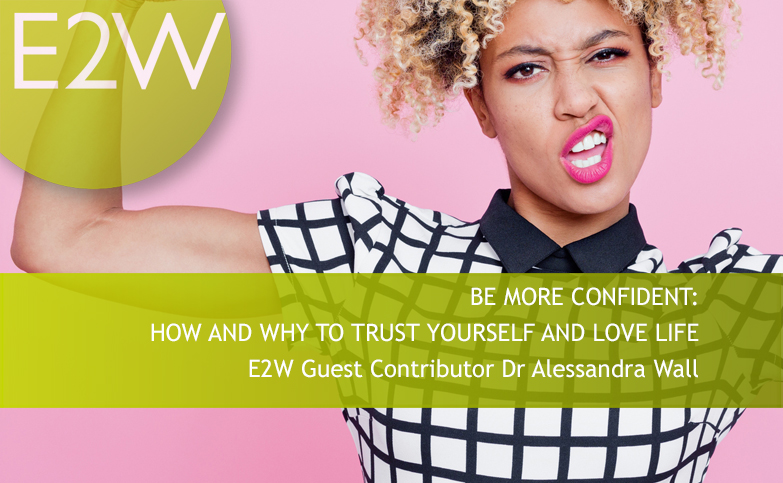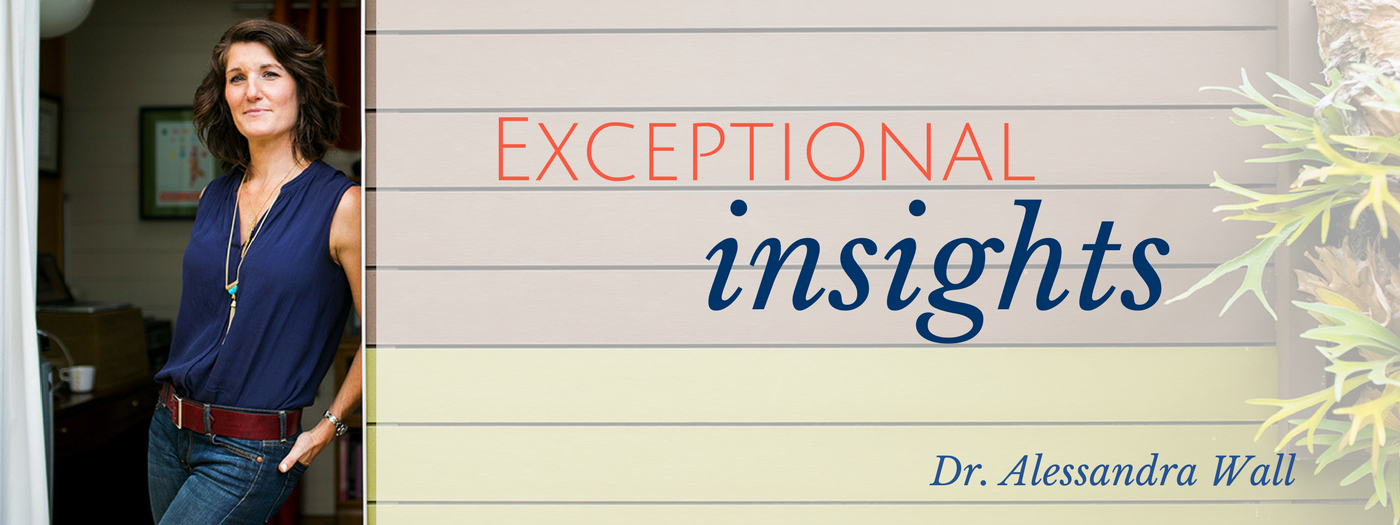
BE MORE CONFIDENT: HOW AND WHY TO TRUST YOURSELF AND LOVE LIFE
Mark.Freed / 31 Oct 2018
At E2W, we are passionate about helping women fulfil their potential within the financial services industry. We understand that achieving potential doesn’t always mean changing roles, but making the most of your existing position. To make that happen, there may be hurdles to overcome and we would like to help you manage those hurdles and, “bridge the gap between the way things are and the way you want them to be.”
We are delighted to introduce you to Dr Alessandra Wall, a psychologist and coach and now a guest contributor to E2W’s Blog and Newsletters. Alessandra is going to help us in our continued mission to support you in your career path by, over the next few months, contributing a series of articles surrounding career progression, managing work scenarios, overcoming self-confidence issues and other pertinent topics. Some of you may already know of Alessandra thanks to her social media presence, or you may have heard her speak.
Alessandra is based in California and she will be visiting us & the E2W community in 2019. In the meantime, please digest and embrace her articles, engage with us and Alessandra – let us know your thoughts, and help us help you reach your career goals.
In her first article for E2W Alessandra covers self-confidence.

Do you struggle with self confidence? Second guess yourself, wonder whether you really know what you’re doing, or know what you want? Nobody trusts themselves 100% of the time, but it sure does seem like some people walk through life unimpeded by self doubt.
You know her: the co-worker who always looks like she knows what she’s doing. That friend who doesn’t immediately shutdown and get defensive when someone disagrees with her.
Or that ridiculously successful celebrity who credits her ascension to greatness to her unwavering faith in her ability to achieve whatever she set her mind to. There are just people out there who exude self confidence.
But that’s not you, at least not yet.
What if I told you that self confidence isn’t about being awesome, or fearless or even believing in yourself?
What if you could be yourself, fuck up every once in a while, be imperfect and still be incredibly and rightfully self confident?
Setting the record straight
What people mean by “self confident” is sometimes confusing, so let me set the record straight so you know what we’re talking about and how to get there:
Self confidence is not!
Self confidence is not self-esteem. Self-esteem is the belief that you are good enough as you are. Think of it as self acceptance or self-worth. Self-esteem is really important, and it’s definitely helpful to have good self esteem if you want to build self confidence. But I know plenty of women out there who don’t fully love or accept themselves as they are, but still have a ton of self confidence.
Self confidence is not the same thing as being gutsy or having balls or being bold. Just because someone acts boldly doesn’t mean they’re confident. Likewise, don’t confuse quiet, reserved and subtle styles for lack of confidence. Let’s be clear – boldness is a style, not a belief. Whether you communicate with audacity or not, says nothing about how confident you might or might not be – although some of the more memorable self-confident women we know are in fact the ones who stand out by their boldness (think Oprah Winfrey).
So what is self confidence?
Self confidence … it’s complicated
Technically, self confidence is the emotional and behavioral expression of self-awareness and trust.
Say what?
Okay, in real people speak. Self confidence is what happens when you know yourself inside and out, and you understand what you need, why you need it and how to make it work for you. It shows up as unwavering trust in your ability to know what’s right for you and take action on that knowledge.
Think about it! The super poised and prepared co-worker, your friend who can be challenged without feeling threatened, and the über successful celebrity have one thing in common. They all know what they need, and they let those needs drive their actions and goals. In other words each one of them knows why she’s doing what she’s doing and why it’s going to work for her.
Because of that understanding and insight, she can easily make choices, set goals, and come-up with a solid plan. Anytime things don’t work the way she’d hoped, she knows she just needs to recalibrate her plan, not scratch it. Why, because she knows her goals, her vision and focus are right for her, and the rest (what she does to get there) are just details.
When you don’t fundamentally understand why you do the things you do, and you can’t define your needs, it’s really hard to trust your choices and stick with them. Because you don’t fully get why something should or shouldn’t matter to you, you can’t stay focused. That’s when you waiver, act indecisively, question your choices, stay up at night wondering what if, and back down when others don’t see things the way you do.
Become that girl, everyone else wants to be:
Now that you understand that self confidence isn’t about thinking you’re perfect, nor about being able to do everything perfectly, the question you should be asking yourself is: “how do I get me some of that?”
As far as I’m concerned there’re only two ways of going about it: the right way, and the might work if you’re lucky much harder way.
Let’s start with the latter.
The might work if you’re lucky approach to self confidence (MWIYL):
Also known as the fake it till you make it approach, the MWIYL approach to self confidence involves making a decision and sticking by it despite uncertainty, fear or self doubt. It’s much harder for a few reason: 1) it requires you to inherently trust that your judgment isn’t awful. 2) There’s actually no guarantee that the choices you’re making are right for you – you know that – which makes it nearly impossible to not feel anxious while you wait for things the play out. 3) Without a good reason for making a choice, other than it seemed the right thing to do, you’re leaving yourself open to being challenged and doubting yourself when it happens .
Having said that, the MWIYL approach can pay off.
The more you practice taking action and addressing the real and outcomes problems (rather than pondering them) the more practice you get making decisions, problem solving and reaping the benefits of good choices. Every success will help you understand what does and doesn’t work for you. Failures that are not catastrophic will remind you that you can handle what life throws your way. And any opportunity to act rather than agonize over a choice teaches you about yourself.
The right way:
Okay, I’m not a huge fan of doing something because it’s the right way. I’m more about doing what’s right for you, so I need you to trust me for a second when I say, this is not just the right way, it’s ultimately what’s right for you.
Do you want to become more confident? Do you want to be that person who steps up, makes decisions, knows what’s right for her, and doesn’t show any hesitation when she asked to make a choice? Good, then follow the three steps I have outlined here.
This is the approach I use, and the one I have my coaching clients and therapy patients use.
Step I: Find out what you need to love life
There are many ways of doing this you could spend years and thousands of dollars in therapy, or you could use my favorite tool, the Focus Map. The Focus Map is actually a process, that has you create a narrative about your ideal life. You then then use that ideal to discover and your needs. It’s actually a really cool exercise, and gets right to the point, and most people come out of it with an immediate set of goals.
You can also use the ‘finding your why’ method, that Simon Sinek introduces in his TED talk. It involves thinking about things you want to do, or looking back on times you’ve felt passionate, or excited then asking yourself why those moments matter. Why they drive you. Why you feel so strongly about them.
It’s a really popular technique in business, marketing and leadership circles.
One final way to define your needs is to practice mindfulness on a daily basis. By getting in tune with your feelings and your thoughts and learning to listen, inquire and observe your reaction you create opportunities for insight and self awareness. This approach is the slowest, but it has the benefit of helping you be more present and self-aware.
Step II: Define how your needs will best be expressed.
It’s not enough to know what you need, you also have to know the best way to express your needs. We each have very specific ways in which our needs are best expressed. When you don’t express your needs in a way that’s right for you, you end-up feeling dissatisfied and disappointed. It’s why so many of us fill our lives with what should be awesome experiences, and we still feel blah.
Imagine ice cream is a general need. There are many different ways you can have ice cream. If you need ice cream in the form of a chocolate milkshake and I give you a vanilla cone, I guarantee you’re going to feel unsatisfied, despite getting ice-cream. It’s the same way with needs.
So once you understand what you need to be fulfilled, then you have to figure out how it should look to be right for you.
Step III: Put it in practice
Once you know something is right for you, you have to practice it. Taking action creates proof. You have try, succeed or fail, make adjustments and try again. Prove to yourself, that you can do it, that you are competent and that you know what’s right for you.
- self-awareness + practice → competence
- self-awareness + competence = self confidence
When I coach people first we define yours need (X). Then you figure out where and how X is best expressed. Soon after that you decide what you’re going to do today to build more of X into you life. The goal is to have you acting on your insight, so that you can trust yourself to make good choices.
I won’t lie, there’s nothing better than seeing someone go from not knowing what they need or should do, to having a clear focus and goals that excite them, and then watch them develop the confidence to act on all of that.
Your next step
If you’re less confident that you’d want to be, there’s hope. You don’t have to second guess yourself, or feel like you don’t know what you need to be happy.
First, get to know yourself. Understand your whys . Why do you get excited about A , but not B? Why do your dreams look the way they do? And why do you need what you need? Then figure out how. How should your needs be expressed? How are you going to build that life, career, relationship that you’re excited to wake up to? After that you can practice your whats – what you’re going to do, say or try next.
Figure out what you need to love life. Create focus with goals that are right for you. Start trusting yourself to know what’s right for you, and feel more confident – that’s what the program’s about.
If you would like to know more about Alessandra she can be contacted via E2W.

Back to blog



 Women in Financial Services
Women in Financial Services